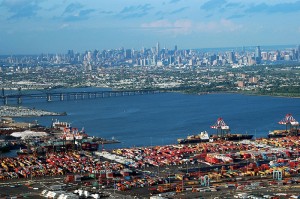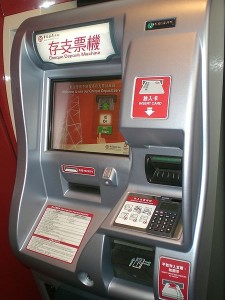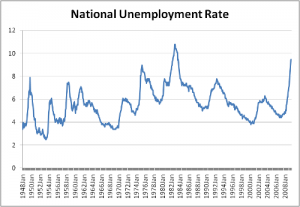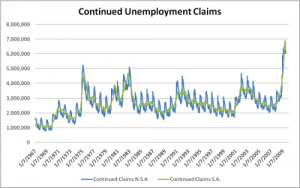
The extent of the market’s shrinkage in 1969-70 should have served to dispel an illusion that had been gaining ground during the past two decades. This was that leading common stocks could be bought at any time and at any price, with the assurance not only of ultimate profit but also that any intervening loss would soon be recouped by a renewed advance of the market to new high levels. That was too good to be true. At long last the stock market has “returned to normal,” in the sense that both speculators and stock investors must again be prepared to experience significant and perhaps protracted falls as well as rises in the value of their holdings. — Ben Graham in “The Intelligent Investor”
For years, investors have been told there is an easy, simple way to invest, requiring very little effort, by using index funds. Many amongst us have been seduced into believing that we can safely invest in stocks, or stay invested, as long as we have a long enough time horizon. This claim is generally based on analyzing the unique market trajectory of the United States, where stocks have outperformed other investments over most long-time periods (20 to 30 years). Of course, over shorter periods (say 5 or 10 years), returns from stocks have been painfully small or even negative, and as Keynes said: “In the long run, we’re all dead.”
In addition to being told that stocks are the best game in town, investors are relentlessly advised to buy large numbers of stocks, via index funds. Too many have taken this easy way out and bought stocks without any sound analysis and we fear the market has begun to reflect this laziness.
I have a parable for you, or perhaps a fable. Imagine market participants as a herd of buffalo on the plain. The herd moves together, often quickly. In the past, it has never run off a cliff because enough buffalo are looking around for the tell-tale signs of a drop-off and slow it down. One morning, a buffalo has the bright idea that since the herd has never run off a cliff (at least not in living memory, or as far back as the data is readily available), it would make sense to simply follow the herd and stop looking for signs of cliff-edges. Once enough buffalo buy into this strategy and become free-riders, the herd itself becomes less aware. As a result, the herd has fewer and fewer buffalo actively participating in picking direction, alert individuals get pushed into the center of the herd, effectively blinding them. This blind herd runs willy-nilly all over the plain, and eventually it will run off a cliff.
Sometimes it makes sense to cut oneself out of the herd in the interest of self-preservation and go your own way, so you can see clearly.
I’d be a bum on the street with a tin cup if the markets were always efficient. — Warren Buffet
We wrote earlier this year about the debate surrounding the Efficient Market Hypothesis (EMH). The EMH, roughly speaking, claims all relevant information that is presently known is incorporated into market prices. For some time now, we’ve viewed the EMH with some skepticism. Two recent editorials, one by Jeremy Siegel in the WSJ, and the other by Martin Wolf in the FT, prompted us to revisit the subject and reiterate our skepticism about the EMH. We think part of the reason these two camps disagree is that they are not trying to answer the same question.
The EMH camp asks the question “what are stocks going to do tomorrow”, and says (with some justification) that it is difficult to predict tomorrow’s moves because the sum total of all market-moving “information” is reflected in the price. In our view, this is not a particularly insightful observation, partly because the question itself is largely irrelevant for an investor (as opposed to a trader).
The Value camp (Ben Graham, Warren Buffet, Jeremy Grantham) believe the right question for an investor to ask is “should we buy stocks today”, or “if we buy stocks today, do we stand a reasonably good chance of achieving an acceptable return”. We believe this is a far more crucial question. The value camp has developed numerous mechanisms to measure the value and risk of an investment based on expected returns.
By convincing many investors that “the market is always right” and that evaluating investment opportunities for themselves is not worthwhile, the EMH camp has successfully encouraged many market participants to become lazy. And if these multitudes ARE the market now, the market itself has stopped evaluating investments on their merits. This is how markets get to be wrong and their self-correcting nature is undermined.
A public-opinion poll is no substitute for thought. — Warren Buffet
In his article, Siegel says the fault for the bubble is not with the EMH, but with market participants (ratings agencies and investors) who failed to do their homework on their investments. That’s pretty rich coming from someone who has been telling investors that doing homework is futile because the market already incorporates all known information. The folks who buy into this notion have stopped looking for information and see no value in doing their own analysis. I am not suggesting that Mr. Siegel and his friends in the EMH camp were the first to promote laziness amongst investors and unknowingly encourage the markets to run off cliffs. Many others before them have touted the same tactics, see the quote from Graham we started with. We’re also certain this won’t be the last attempt to lull investors into believing easy gains are possible from investing in stocks, or houses, or any other asset for that matter. As we’ve seen over the past year, this is the stuff of which tragedies are made.
![]()




 Todd Woody writes in the New York Times on
Todd Woody writes in the New York Times on 








